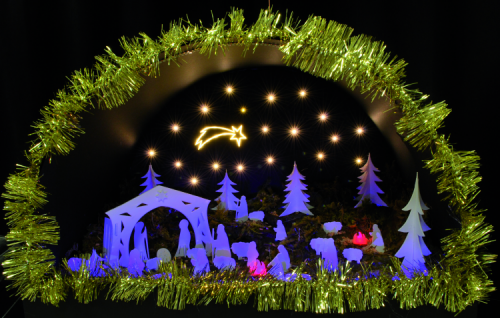
Practical realisation
Let’s move now onto the subject of the board’s construction, that requires the preparation (or the purchase, since all the materials are available at Futura Elettronica) of a double-sided printed circuit board, whose tracks can be downloaded from our website, along with the other project files. Once the stripboard has been engraved and pierced, and the leads have been created (that is to say, the interconnections between pads that are common to the two sides) it is possible to mount the components, starting with the ones having the lowest profile (resistors and D1 Diode), and going on with the microcontroller’s socket, the 6-poles pin-strip with 90° terminals for the (optional) USB/Serial converter, the trimmers, the PCB buttons and the LEDs (to be orientated as shown on the assembling plane, and taking into account that the cathode is the electrode that has been placed on the container’s smoothed side). Please insert and weld the two female 8-pole pin-strips now, so to mount the audio module, the pin-strip for the ICSP (4 poles), the eight terminal boxes and the 7805 regulator, that must be kept upright, with the side having the writings pointed towards the microcontroller’s socket. Now the six MOSFETs must be mounted: each one of them has to be inserted in the corresponding hole in the printed circuit board, after having bent the terminals with a right angle and having put it on (with the side having the writings facing upwards) a “U” heat dissipator of the ML26 kind (thermal resistance: 22° C/W).
Once the weldings have been completed and you have verified that each component has been correctly mounted, and in the expected direction, please insert the DFR0299 module in its pin-strips (by orientating it so that the SD-carrier is pointed towards the outside of the circuit) and the microcontroller, whose reference notch must be pointed towards the integrated U2 regulator.
A micro SD card having the desired capacity must be inserted in the DFR0299, with the chosen audio files already loaded (please do it on a computer); what we claimed a few paragraphs above is valid for them as well. Please remember that – for obvious reasons – the duration of each one of them must not exceed the one that has been set for the phase it has to go with, thus, as an example, the theme being played for the day phase must not last more than the duration set for the day. It is not a problem if the file lasts less, since – it being the case – the file is cyclically reproduced until the end of the time set for the corresponding phase, and therefore faded out in time.
Please remember that the tracks must preferably be placed in the micro sd’s root, but anyway the module is capable of looking into the folders, it being understood that the reproduction order provided for our board would no longer be guaranteed.
At this stage, the control box may require the programming or not, depending on how you created it: if you have acquired a “virgin” microcontroller you will have (by means of the ATMEL programmer or of an Arduino board that has been set as a programmer: that’s the stand-alone programming technique) to load the bootloader by using, for the purpose, the ICSP connection. Once this has been carried out, by removing the programmer and by mounting the USB/Serial interface module in the U4 connector (it is the FT782M, a module that is available at Futura Elettronica, www.futurashop.it, and that is based on FTDI’s integrated circuit, FT232RL), the latter’s USB socket has to be connected to the one of the PC on which the Arduino IDE has been installed, and then the sketch has to be loaded (the IDE sees our board as if it was an Arduino UNO, since the bootloader loaded into the ATmega 328P is the same).
All of this is not required if you purchased the assembly kit, in which the microcontroller has been provided with all the basic functions programmed (4 outputs managed by 4 trimmers).
Anyway, in order to make our project easily adaptable to the user’s needs, the sketch is given in an open source format, and you will be able to download it, always from our website, along with the project files.
Therefore, even if you purchased the kit and are not satisfied with the basic configuration, and want to try to make some changes, you will have to acquire and mount the USB/Serial converter.
Original article published at Open Electronics
[tps_footer][/tps_footer]












